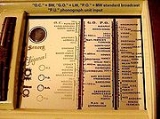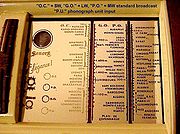
Wave plan of Geneva
Encyclopedia
The Geneva Frequency Plan of 1975 (Aka "The Final Acts of the Regional Administrative LF/MF Broadcasting Conference (Regions 1 and 3) Geneva, 1975" or simply "GE75") is the internationally agreed frequency plan which was drawn up to implement the provisions of the Final Acts of the Regional Administrative LF/MF Broadcasting Conference (Regions 1 and 3) held in Geneva
, Switzerland
, in 1975. It covers radio broadcasting in the long
and medium wave
bands outside the Americas (separate agreements
being in place for North and South America).
The plan was drawn up under the auspices of the World Administrative Radio Conference
(WARC) of the International Telecommunication Union
(ITU) with the assistance of the European Broadcasting Union
(EBU/UER).
The Geneva plan replaced the 1948 Copenhagen plan. It became necessary because of the large number of broadcasting stations in these frequency ranges leading to ever more mutual interference (Many countries had refused to ratify the Copenhagen plan and compliance was patchy even among those which had). The Geneva plan entered into force on 23 November 1978 and although its intended lifespan was only until 1989 it is still valid (with small modification by mutual coordination between countries) today. The ability for countries to agree subsequent amendments to the plan has given sufficient flexibility to ensure that compliance has been far more widespread.
Most existing European radio stations were required to change their broadcasting frequencies following implementation of the plan. In most cases the changes were slight (only one or two kilohertz) but were more drastic in some cases, particularly in the United Kingdom
, where all BBC national stations moved to a new wavelength or band.http://www.mds975.co.uk/Content/ukradio3.html However the increased number of radio services and reduction (in most cases) of interference to radio signals (particularly at nighttime) was considered by most broadcasters to be worth the initial inconvenience.
As a result of the plan most medium wave (and later longwave) stations outside North and South America operate on exact multiples of 9 kHz which helps reduce heterodyne
interference.

Geneva
Geneva In the national languages of Switzerland the city is known as Genf , Ginevra and Genevra is the second-most-populous city in Switzerland and is the most populous city of Romandie, the French-speaking part of Switzerland...
, Switzerland
Switzerland
Switzerland name of one of the Swiss cantons. ; ; ; or ), in its full name the Swiss Confederation , is a federal republic consisting of 26 cantons, with Bern as the seat of the federal authorities. The country is situated in Western Europe,Or Central Europe depending on the definition....
, in 1975. It covers radio broadcasting in the long
Longwave
In radio, longwave refers to parts of radio spectrum with relatively long wavelengths. The term is a historic one dating from the early 20th century, when the radio spectrum was considered to consist of long, medium and short wavelengths...
and medium wave
Mediumwave
Medium wave is the part of the medium frequency radio band used mainly for AM radio broadcasting. For Europe the MW band ranges from 526.5 kHz to 1606.5 kHz...
bands outside the Americas (separate agreements
North American Radio Broadcasting Agreement
The North American Radio Broadcasting Agreement, usually referred to as NARBA, is a treaty that took effect in March 1941 and set out the bandplan and interference rules for mediumwave AM broadcasting in North America. Although mostly replaced by other agreements in the 1980s, the basic bandplan...
being in place for North and South America).
The plan was drawn up under the auspices of the World Administrative Radio Conference
World Administrative Radio Conference
The World Administrative Radio Conference was a technical conference of the International Telecommunications Union where delegates from member nations of the ITU met to revise or amend the entire international Radio Regulations pertaining to all telecommunication services throughout the world...
(WARC) of the International Telecommunication Union
International Telecommunication Union
The International Telecommunication Union is the specialized agency of the United Nations which is responsible for information and communication technologies...
(ITU) with the assistance of the European Broadcasting Union
European Broadcasting Union
The European Broadcasting Union is a confederation of 74 broadcasting organisations from 56 countries, and 49 associate broadcasters from a further 25...
(EBU/UER).
The Geneva plan replaced the 1948 Copenhagen plan. It became necessary because of the large number of broadcasting stations in these frequency ranges leading to ever more mutual interference (Many countries had refused to ratify the Copenhagen plan and compliance was patchy even among those which had). The Geneva plan entered into force on 23 November 1978 and although its intended lifespan was only until 1989 it is still valid (with small modification by mutual coordination between countries) today. The ability for countries to agree subsequent amendments to the plan has given sufficient flexibility to ensure that compliance has been far more widespread.
Most existing European radio stations were required to change their broadcasting frequencies following implementation of the plan. In most cases the changes were slight (only one or two kilohertz) but were more drastic in some cases, particularly in the United Kingdom
United Kingdom
The United Kingdom of Great Britain and Northern IrelandIn the United Kingdom and Dependencies, other languages have been officially recognised as legitimate autochthonous languages under the European Charter for Regional or Minority Languages...
, where all BBC national stations moved to a new wavelength or band.http://www.mds975.co.uk/Content/ukradio3.html However the increased number of radio services and reduction (in most cases) of interference to radio signals (particularly at nighttime) was considered by most broadcasters to be worth the initial inconvenience.
As a result of the plan most medium wave (and later longwave) stations outside North and South America operate on exact multiples of 9 kHz which helps reduce heterodyne
Heterodyne
Heterodyning is a radio signal processing technique invented in 1901 by Canadian inventor-engineer Reginald Fessenden where high frequency signals are converted to lower frequencies by combining two frequencies. Heterodyning is useful for frequency shifting information of interest into a useful...
interference.
Predecessors to the GE75 Plan
- Geneva 1925 (effective 14 Nov 1926) 10 kHz spacings on MW;
- Brussels 1928 (effective 13 Jan 1929) 9 kHz spacings on MW (10 kHz above 1000 kHz);
- Prague 1929 http://www.fcc.gov/ftp/Bureaus/Mass_Media/Databases/documents_collection/radio_service_bulletins/290531.pdf(effective 30 June 1929) "European Radio-electric Conference of Prague 1929" 9 kHz spacings on MW (10 kHz above 1400 kHz);
- Madrid/Lucerne 1932 http://www.bbceng.info/Technical%20Reviews/Development_of_the_BBC_AM_Transmitter_Network4.pdf (effective 15 Jan 1934) "Lucerne Convention European Wavelength Plan" Mostly 9 kHz spacings but not harmonic multiples;
- Montreaux 1939 (was to be effective 1940 but never implemented due to World War II);
- Copenhagen 1948 http://buizenradio.verdijk.info/afstemschaal/kopenhagen.htmlhttp://www.hermanboel.eu/radiohistory/images/lists/eur_1948_kopenhagen.gifhttp://www.msz.gov.pl/bpt/documents/10875.pdf (effective 15 Mar 1950) "European LW/MW Conference Copenhagen 1948 (European broadcasting convention)" Mostly 9 kHz (8 kHz above 1529 kHz 7, 8 and 9 kHz on LW) spacings but not harmonic multiples—offset 1 kHz on MW and (generally) 2 kHz on LW.

See also
- AM radio
- MediumwaveMediumwaveMedium wave is the part of the medium frequency radio band used mainly for AM radio broadcasting. For Europe the MW band ranges from 526.5 kHz to 1606.5 kHz...
- MW DXMW DXMW DX, short for mediumwave DXing, is the hobby of receiving the reception of distant mediumwave radio stations. MW DX is similar to TV and FM DX in that broadcast band stations are the reception targets...
- LongwaveLongwaveIn radio, longwave refers to parts of radio spectrum with relatively long wavelengths. The term is a historic one dating from the early 20th century, when the radio spectrum was considered to consist of long, medium and short wavelengths...
- North American Radio Broadcasting AgreementNorth American Radio Broadcasting AgreementThe North American Radio Broadcasting Agreement, usually referred to as NARBA, is a treaty that took effect in March 1941 and set out the bandplan and interference rules for mediumwave AM broadcasting in North America. Although mostly replaced by other agreements in the 1980s, the basic bandplan...

